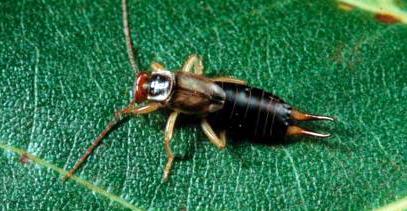Unused stories
Pest of the Month - Earwigs
They don't really crawl in your ears
Ever strolled through your garden, spied a particularly lovely flower, and as you deeply inhaled its sweet fragrance, out comes an earwig, almost crawling up your nose? Yuk! That’s almost as bad as the supposed genesis of the name earwig - the old wives tale that has these creepy insects crawling into sleeping people’s ears and tunneling into their brain. Who are these creatures and what are they doing on your plants? Are they bad bugs or beneficials?
Earwigs are nocturnal and communal creatures; they gather during the day in moist, dark, tight hiding places in the garden - under rocks or stones, loose clods of soil or boards; around vegetables, dense growth of vines or weeds, in flower blossoms, or even within fruit damaged by other pests. As moisture-loving insects, they thrive in the conditions of an irrigated garden where they can remain active all year. And, if it gets too dry, too hot or cold outside, they may take up residence indoors.
Sometimes called pincerbugs, these easily recognized insects sport a pair of prominent appendages that resemble forceps and are used for defense. The reddish-brown adult is about 3/4- inch long; young ones look like adults except they’re smaller and lack wings. The earwigs’ body is quite maneuverable and other than an occasional weak pinch from their ferocious-looking pinchers (if mishandled), earwigs don't hurt humans. However, they can emit a foul-smelling, yellowish brown liquid from special glands when threatened.
They’re not particularly discriminating eaters and consume a wide variety of materials both living and dead, acting in part as recyclers. They eat insects and mites, are voracious feeders of aphids and insect eggs, but may also gobble up beneficial insects. Growing shoots of plants, soft fruits, sweet corn, zinnias, marigolds and dahlias flowers are some of their favored meals. The damage they cause can mimic that of caterpillars - older plant leaves sport numerous irregular holes or chewed leaf margins. Seedlings may be missing all or parts of their leaves and stem.
Management of these creatures is not easy; decide if you can tolerate the bit of damage they do in exchange for their potentially beneficial role. The best control is keeping plants strong and healthy enough to withstand a little nibbling. Reduce their hiding places – eliminate dense undergrowth of vines, ground cover and weeds around vegetable and flower gardens; prune away fruit tree suckers; remove leaves, boards, boxes, trash, and other debris from planting areas. Lowering surface moisture levels by using drip irrigation rather than overhead watering can also help reduce their numbers.
Trapping earwigs is easy; place hollow pieces of bamboo, a length of old garden hose, or rolled up newspapers on shaded, moist soil – they will seek shelter in these so that you can simply toss them into a bucket of water and drown them, or dispose in a garbage can sitting in bright sunlight. Alternatively, shallow containers filled with vegetable oil or soapy water can be buried up to their rim in your garden, where earwigs, and probably the odd slug or other bug will drown in the liquid.
While these rather unsightly little creatures can be a help in the garden by consuming pests and assisting in breaking down dead material, they can also do some damage. Even in large numbers, while annoying, they present no health hazards. So, what did you decide - in your garden, are they a good guy or bad guy?
By Nanette Londeree
